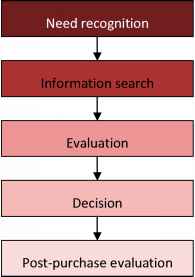Buying process
Before the purchase decision is made, the decision maker goes through several steps of buying process (Palmer, 2001).

Figure 3 - Buying process (adapted from Palmer, 2001)
The process is started by identifying need, which is a motivator of an action that would satisfy the need. Then, the information are sought for in order to find the best solution. Subsequently, the alternatives are assessed and the final decision is made. After the purchase, the buyer evaluates it.
Fisk (1981) further developed a model of buying process for using in the service sector. The model divides buying process into three stages - pre-consumption, consumption and post-consumption stage. During the first stage, a decision-maker identifies the solution, which he or she expects to be the best. In the next stage, the service is consumed and the actual experience is matched with expectations raised in the previous stage. If the expectations are not met, it leads to dissatisfaction. In the last stage, the service is evaluated and the satisfaction with the product or service increases the motivation to buy it again in the future or continue using it, whilst dissatisfaction leads to opposite results.
|
PRE-CONSUMPTION 1 CONSUMPTION . POST-CONSUMPTION STAGE STAGE 1 STAGE | |||
|
Ne 1 ation / 1 |
C^ 1 1 1 |
hase lation | |
|
Decisi to |
1 |
itinue I No fv lases pure |
r jrther hases |
Figure 4 - Evaluation process model for services, Fisk, 1981
Figure 4 - Evaluation process model for services, Fisk, 1981
For the purpose of this work, the evaluation of alternatives and decision to buy stages will be researched, as they are crucial for answering the above mentioned research questions.
Was this article helpful?